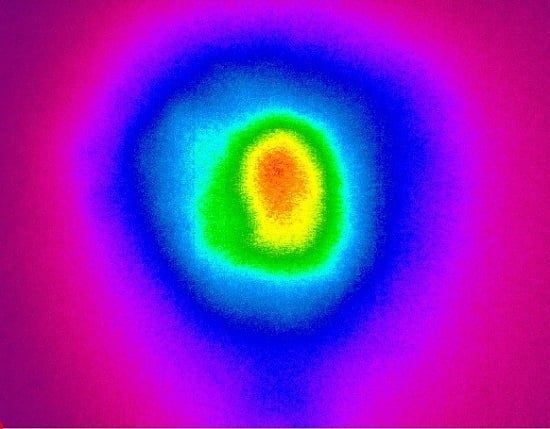Random Laser Action in Nd:YAG Crystal Powder
Abstract
:1. Introduction
2. Sample Preparation and Characterization
3. Experimental Setup
4. Results
5. Conclusions
Acknowledgments
Author Contributions
Conflicts of Interest
References
- Cao, H. Lasing in random media. Waves Random Media 2003, 13, R1–R39. [Google Scholar] [CrossRef]
- Wiersma, D.S. The physics and applications of random lasers. Nat. Phys. 2008, 4, 359–367. [Google Scholar] [CrossRef]
- Noginov, M.A. Solid-State Random Lasers; Springer: Berlin, Germany, 2005. [Google Scholar]
- Gouedard, C.; Husson, D.; Sauteret, C.; Auzel, F.; Migus, A. Generation of spatially incoherent short pulses in laser pumped neodymium stoichiometric crystals and powders. J. Opt. Soc. Am. B 1993, 10, 2358–2363. [Google Scholar] [CrossRef]
- Redding, B.; Choma, M.A.; Cao, H. Speckle-free laser imaging using random laser illumination. Nat. Photonics 2012, 6, 355–359. [Google Scholar] [CrossRef] [PubMed]
- Wiersma, D.S.; Cavalieri, S. Light emission: A temperature-tunable random laser. Nature 2001, 414, 708–709. [Google Scholar] [CrossRef] [PubMed]
- Consoli, A.; Mariano da Silva, D.; Wetter, N.U.; López, C. Large area resonant feedback random lasers based on dye-doped biopolymer films. Opt. Express 2015, 23, 29954–29963. [Google Scholar] [CrossRef] [PubMed]
- Kéna-Cohen, S.; Stavrinou, P.N.; Bradley, D.C.; Maier, S.A. Random lasing in low molecular weight organic thin films. Appl. Phys. Lett. 2011, 99. [Google Scholar] [CrossRef]
- Polson, R.C.; Vardenya, Z.V. Random lasing in human tissues. Appl. Phys. Lett. 2004, 85, 1289–1291. [Google Scholar] [CrossRef]
- Van der Molen, K.L.; Mosk, A.P.; Lagendijk, A. Quantitative analysis of several random lasers. Opt. Commun. 2007, 278, 110–113. [Google Scholar] [CrossRef]
- Balachandran, R.M.; Lawandy, N.M.; Moon, J.A. Theory of laser action in scattering gain media. Opt. Lett. 1997, 22, 319–321. [Google Scholar] [CrossRef] [PubMed]
- Uppu, R.; Mujumdar, S. Physical manifestation of extreme events in random lasers. Opt. Lett. 2015, 40, 5046–5049. [Google Scholar] [CrossRef] [PubMed]
- Berger, G.A.; Kempe, M.; Genack, A.Z. Dynamics of stimulated emission from random media. Phys. Rev. E 1997, 56, 6118–6122. [Google Scholar] [CrossRef]
- Noginov, M.A.; Fowlkes, I.N.; Zhu, G.; Novak, J. Random laser thresholds in cw and pulsed regimes. Phys. Rev. A 2004, 70. [Google Scholar] [CrossRef]
- Noginov, M.A.; Novak, J.; Williams, S. Modeling of photon density dynamics in random lasers. Phys. Rev. A 2004, 70. [Google Scholar] [CrossRef]
- Azkargorta, J.; Bettinelli, M.; Iparraguirre, I.; García-Revilla, S.; Balda, R.; Fernández, J. Random lasing in Nd:LuVO4 crystal powder. Opt. Express 2011, 19, 19591–19599. [Google Scholar] [CrossRef] [PubMed]
- Fujii, G.; Matsumoto, T.; Takahashi, T.; Ueta, T. Study on transition from photonic-crystal laser to random laser. Opt. Express 2012, 20, 7300–7315. [Google Scholar] [CrossRef] [PubMed]
- Fujii, G.; Matsumoto, T.; Takahashi, T.; Ueta, T. A study on the effect of filling factor for laser action in dielectric random media. Appl. Phys. A 2012, 107, 35–42. [Google Scholar] [CrossRef]
- Zhu, H.; Shan, C.-X.; Zhang, J.-Y.; Zhang, Z.-Z.; Li, B.-H.; Zhao, D.-X.; Yao, B.; Shen, D.-Z.; Fan, X.-W.; Tang, Z.-K.; et al. Low-threshold electrically pumped random lasers. Adv. Mater. 2010, 22, 1877–1881. [Google Scholar] [CrossRef] [PubMed]
- Milner, V.; Genack, A.Z. Photon localization laser: Low-threshold lasing in a random amplifying layered medium via wave localization. Phys. Rev. Lett. 2005, 94. [Google Scholar] [CrossRef] [PubMed]
- Patra, M. Decay rate distributions of disordered slabs and application to random lasers. Phys. Rev. E 2003, 67. [Google Scholar] [CrossRef] [PubMed]
- Jiang, X.; Feng, S.; Soukoulis, C.M.; Zi, J.; Joannopoulos, J.D.; Cao, H. Coupling, competition, and stability of modes in random lasers. Phys. Rev. B 2004, 69. [Google Scholar] [CrossRef]
- Türeci, H.E.; Douglas-Stone, A.; Ge, L. Theory of the spatial structure of nonlinear lasing modes. Phys. Rev. A 2007, 76. [Google Scholar] [CrossRef]
- Andreasen, J.; Asatryan, A.A.; Botten, L.C.; Byrne, M.A.; Cao, H.; Ge, L.; Labonté, L.; Sebbah, P.; Stone, A.D.; Türeci, H.E.; et al. Modes of random lasers. Adv. Opt. Photonics 2011, 3, 88–127. [Google Scholar] [CrossRef]
- Fujii, G.; Matsumoto, T.; Takahashi, T.; Ueta, T. Finite-element analysis of lasing modes within photonic random media. J. Phys. B 2012, 45. [Google Scholar] [CrossRef]
- Koechner, W. Solid-State Laser Engineering; Sixth Revised and Updated Edition; Springer Science + Business Media Inc.: New York, NY, USA, 2006. [Google Scholar]
- Lichmanov, A.A.; Brickina, C.M.; Lichmanova, V.N.; Soschin, N.P.; Zolin, V.F. Experimental studies of the lanthanide doped lasing powders (plasers). In Proceedings of the International Conference LASERS’98, Tucson, AZ, USA, 7–11 December 1998; pp. 725–731.
- Feng, Y.; Lu, J.; Wang, S.; Ueda, K.I. Random lasing in Nd:YAG nano-crystalline-powder pumped by laser diode. In Proceedings of the SPIE, Photonic Crystal Materials and Nanostructures, Strasbourg, France, 15 September 2004.
- Feng, Y.; Ueda, K.I. One-mirror random laser. Phys. Rev. A 2003, 68. [Google Scholar] [CrossRef]
- Feng, Y.; Bisson, J.F.; Lu, J.; Huang, S.; Takaichi, K.; Shirakawa, A.; Musha, M.; Ueda, K.I. Thermal effects in quasi continuous-wave Nd3+:Y3Al5O12 nanocrystalline-powder random laser. Appl. Phys. Lett. 2004, 84, 1040–1042. [Google Scholar] [CrossRef]
- Feng, Y.; Huang, S.; Qin, G.; Musha, M.; Ueda, K.I. Random microchip laser. Opt. Express 2005, 13, 121–126. [Google Scholar] [CrossRef] [PubMed]
- Iparraguirre, I.; Azkargorta, J.; Merdrignac-Conanec, O.; Al-Saleh, M.; Chlique, C.; Zhang, X.; Balda, R.; Fernández, J. Laser action in Nd3+-doped lanthanum oxysulfide powders. Opt. Express 2012, 20, 23690–23699. [Google Scholar] [CrossRef] [PubMed]
- Azkargorta, J.; Iparraguirre, I.; Bettinelli, M.; Cavalli, E.; Barredo-Zuriarrain, M.; García-Revilla, S.; Balda, R.; Fernández, J. Effects of pumping wavelength and pump density on the random laser performance of stoichiometric Nd crystal powders. Opt. Express 2014, 22, 27365–27372. [Google Scholar] [CrossRef] [PubMed]
- Iparraguirre, I.; Azkargorta, J.; Fernández, J.; Balda, R.; García-Revilla, S.; Hakmeh, N. On the temporal behavior of Nd3+ random lasers. Opt. Lett. 2013, 38, 3646–3649. [Google Scholar] [CrossRef] [PubMed]
- Iparraguirre, I.; Azkargorta, J.; Kamada, K.; Yoshikawa, A.; Rodríguez-Mendoza, U.R.; Lavín, V.; Barredo-Zuriarrain, M.; Balda, R.; Fernández, J. Random laser action in stoichiometric Nd3Ga5O12 garnet crystal powder. Laser Phys. Lett. 2016, 13. [Google Scholar] [CrossRef]
- Siegman, A.E. Oscillation dynamics and oscillation threshold. In Lasers; Oxford University Press: Mill Valey, CA, USA, 1986; pp. 491–557. [Google Scholar]
- Bahoura, M.; Morris, K.J.; Zhu, G.; Noginov, M.A. Dependence of the Neodymium Random Laser Threshold on the Diameter of the Pumped Spot. IEEE J. Quantum Electron. 2005, 41, 677–685. [Google Scholar] [CrossRef]
- Bahoura, M.; Morris, K.J.; Noginov, M.A. Threshold and slope efficiency of Nd0.5La0.5Al3(BO3)4 ceramic random laser: Effect of pumped spot size. Opt. Commun. 2002, 201, 405–411. [Google Scholar] [CrossRef]

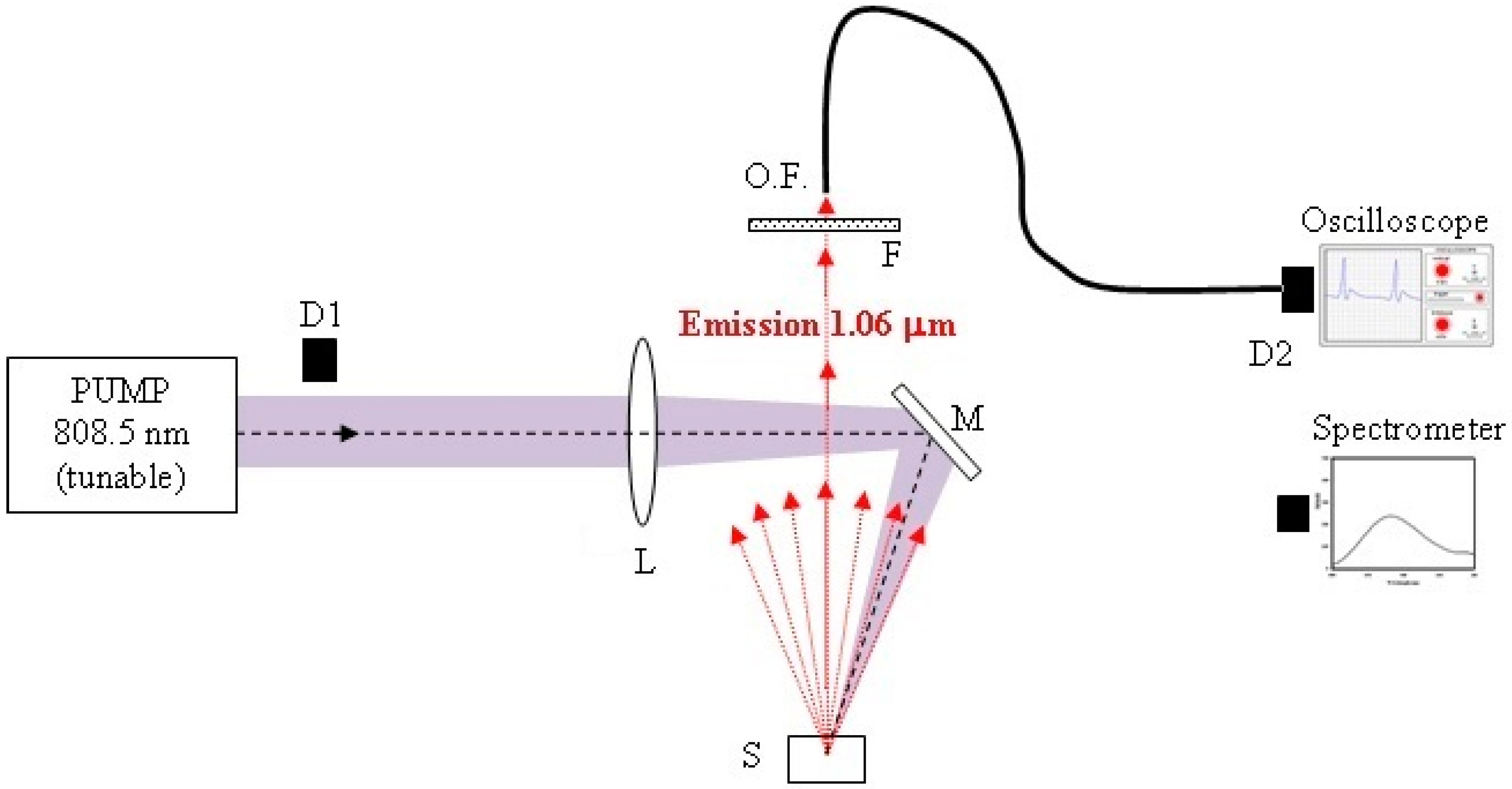
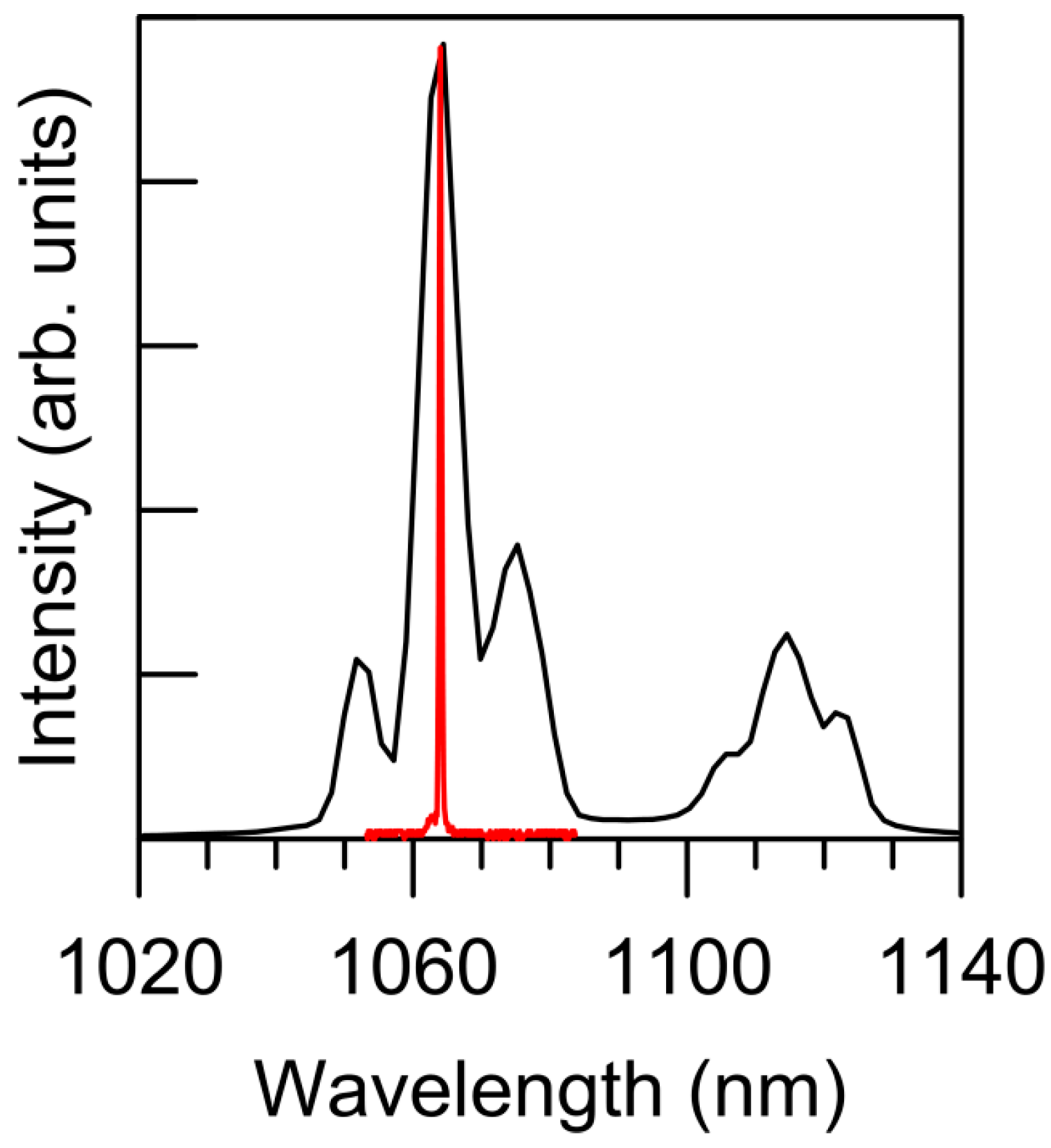
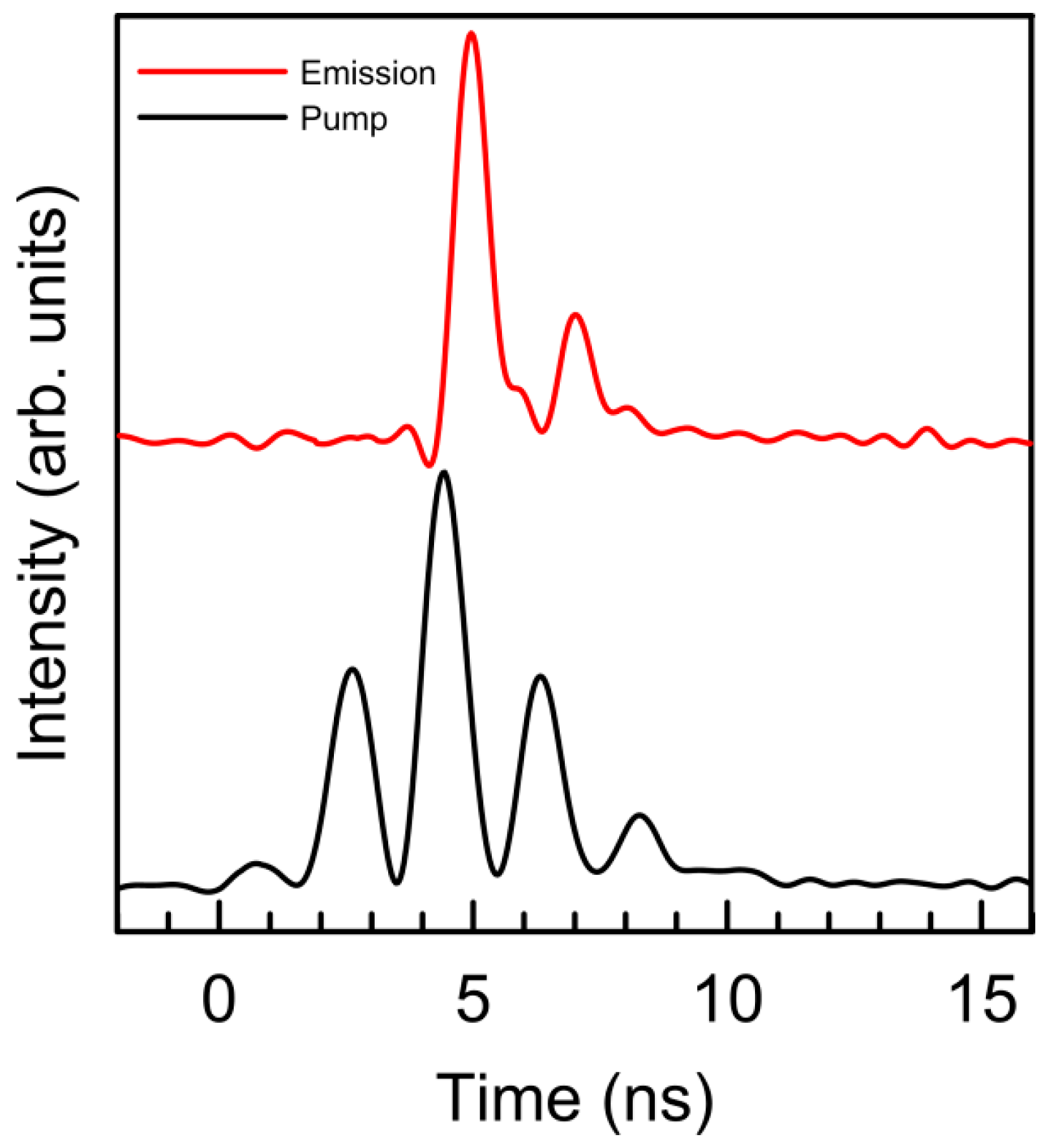
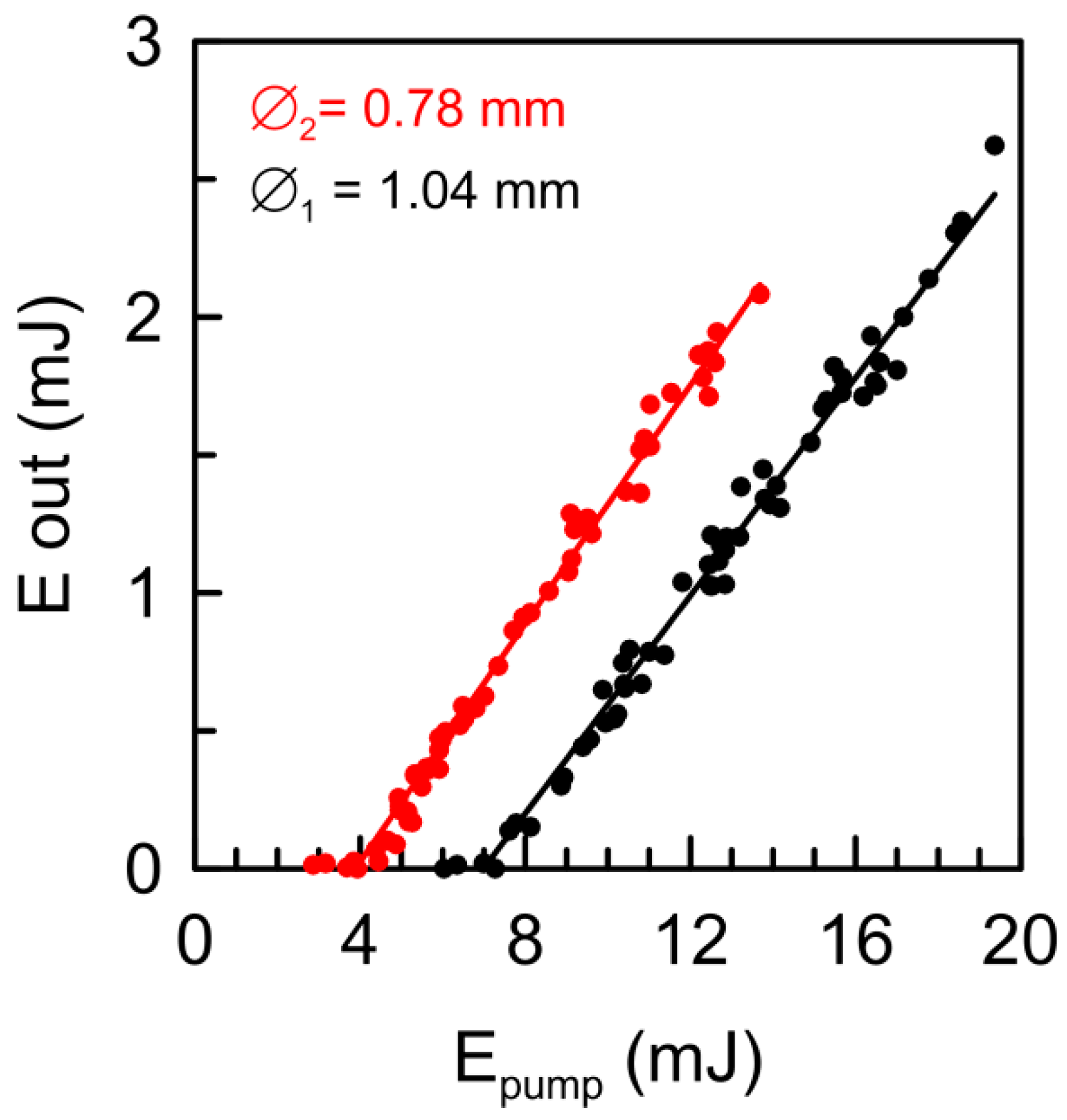
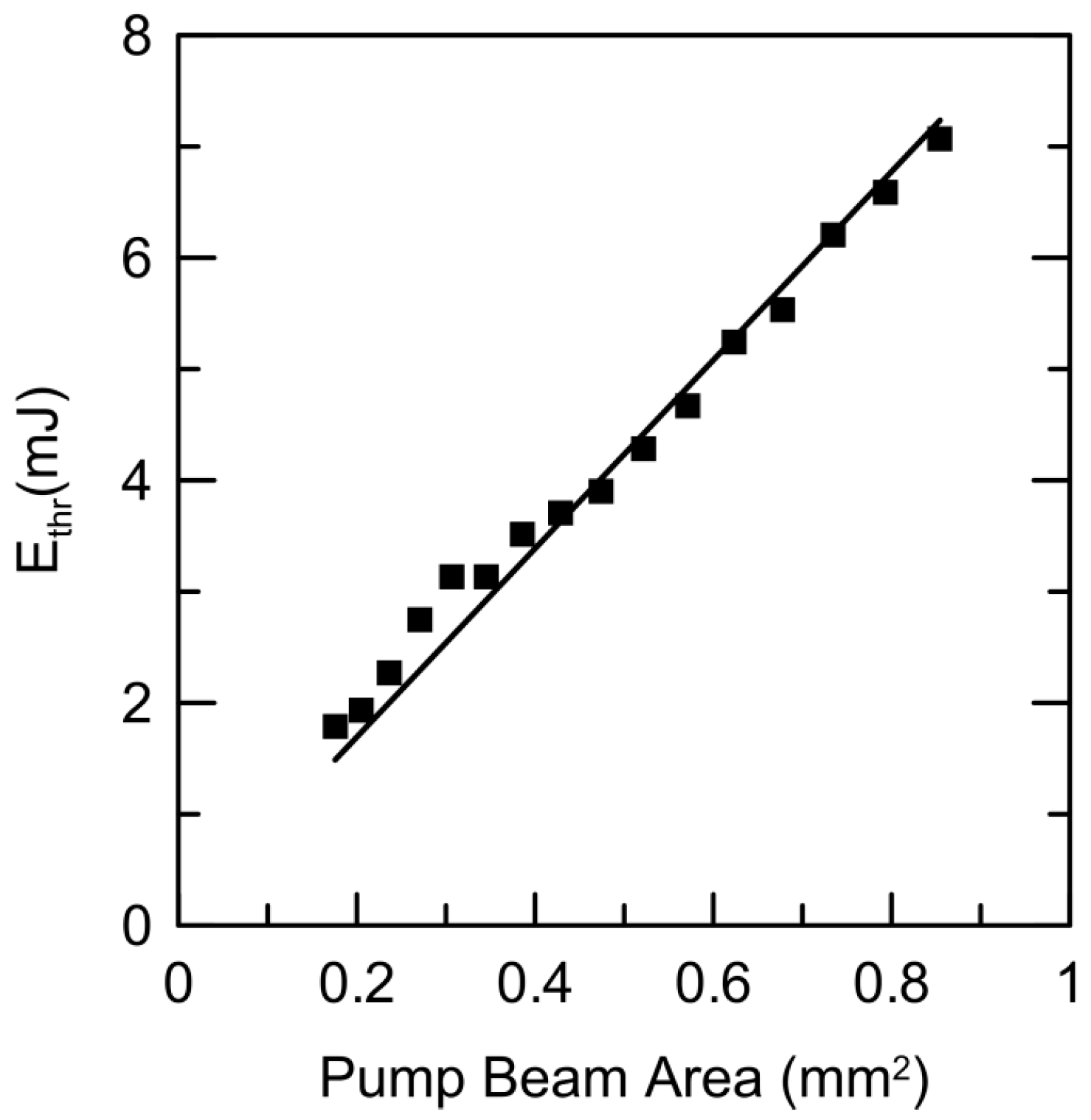

© 2016 by the authors; licensee MDPI, Basel, Switzerland. This article is an open access article distributed under the terms and conditions of the Creative Commons Attribution (CC-BY) license (http://creativecommons.org/licenses/by/4.0/).
Share and Cite
Azkargorta, J.; Iparraguirre, I.; Barredo-Zuriarrain, M.; García-Revilla, S.; Balda, R.; Fernández, J. Random Laser Action in Nd:YAG Crystal Powder. Materials 2016, 9, 369. https://doi.org/10.3390/ma9050369
Azkargorta J, Iparraguirre I, Barredo-Zuriarrain M, García-Revilla S, Balda R, Fernández J. Random Laser Action in Nd:YAG Crystal Powder. Materials. 2016; 9(5):369. https://doi.org/10.3390/ma9050369
Chicago/Turabian StyleAzkargorta, Jon, Iñaki Iparraguirre, Macarena Barredo-Zuriarrain, Sara García-Revilla, Rolindes Balda, and Joaquín Fernández. 2016. "Random Laser Action in Nd:YAG Crystal Powder" Materials 9, no. 5: 369. https://doi.org/10.3390/ma9050369
APA StyleAzkargorta, J., Iparraguirre, I., Barredo-Zuriarrain, M., García-Revilla, S., Balda, R., & Fernández, J. (2016). Random Laser Action in Nd:YAG Crystal Powder. Materials, 9(5), 369. https://doi.org/10.3390/ma9050369




